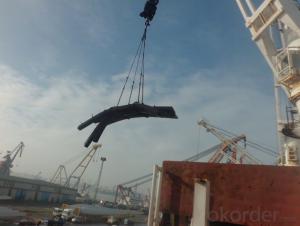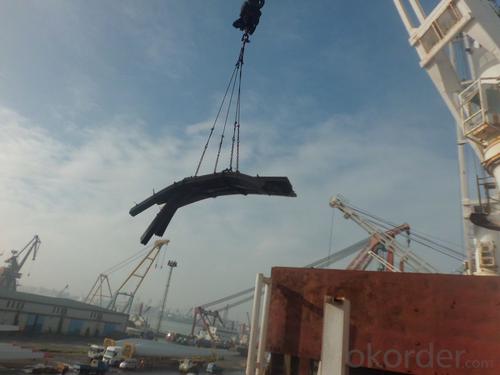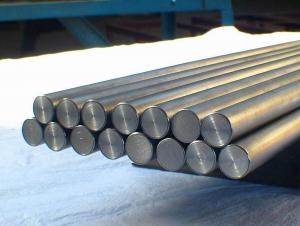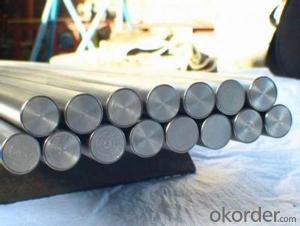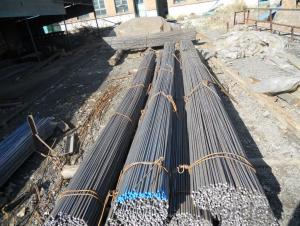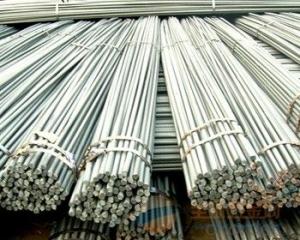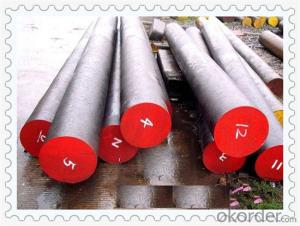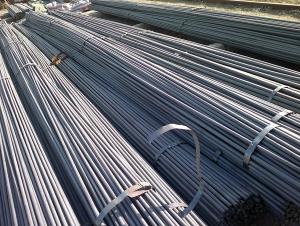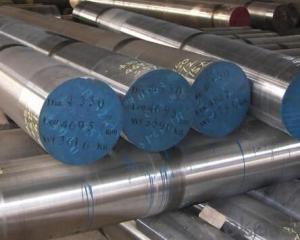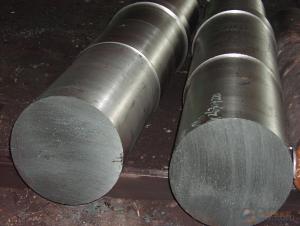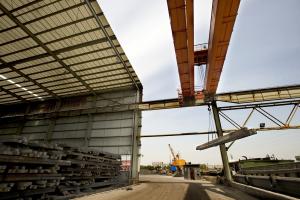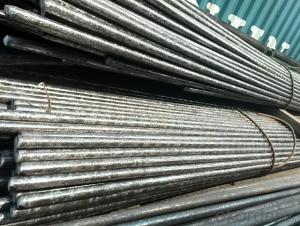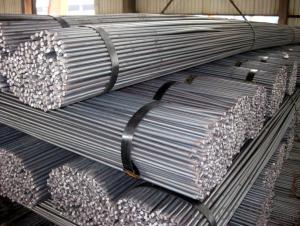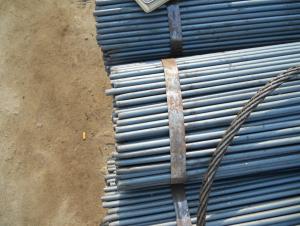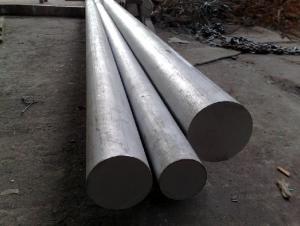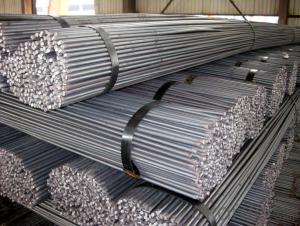stainless round bar steel
- Loading Port:
- China Main Port
- Payment Terms:
- TT OR LC
- Min Order Qty:
- -
- Supply Capability:
- -
OKorder Service Pledge
Quality Product, Order Online Tracking, Timely Delivery
OKorder Financial Service
Credit Rating, Credit Services, Credit Purchasing
You Might Also Like
Product Description:
Quick Details
| Standard: | Dimensions: | Grade: | |||
| Place of Origin: | Brand Name: | Model Number: | |||
| Type: | Application: | Shape: | |||
| Certification: | Steel Grade: |
Packaging & Delivery
| Packaging Detail: | in bundle |
| Delivery Detail: | depend on the quantity, but the earliest time will be 15days |
Specifications
AISI316 stainless steel round bar
surface finish:bright and polished
Moq:5tons
Delivery time within 15days
- Q: What is the difference between a smooth and a ribbed steel round bar?
- The surface texture and intended use differentiate a smooth steel round bar from a ribbed steel round bar. A smooth steel round bar possesses a surface that is uniform and even, devoid of any ridges or indentations. Its application is mainly in projects that desire a sleek and polished appearance, like decorative or architectural endeavors. Additionally, smooth bars find common usage in machining processes where precision and accuracy necessitate a smooth surface. Conversely, a ribbed steel round bar comprises raised ridges or ribs along its length. These ridges contribute to better grip and traction, making ribbed bars optimal for tasks demanding substantial strength and stability. In the construction industry, ribbed bars are frequently employed to reinforce concrete structures such as buildings, bridges, and highways. The ridges on the bar heighten the bond between the concrete and the steel, thereby enhancing the overall structural integrity. To sum up, the key contrast between a smooth and ribbed steel round bar lies in their surface texture and intended use. Smooth bars are valued for their polished appearance and precision machining, whereas ribbed bars are designed to deliver enhanced grip and reinforcement in concrete structures.
- Q: Can steel round bars be used for structural purposes?
- Yes, steel round bars can be used for structural purposes. They are commonly used in the construction industry for various applications, such as providing support and reinforcement in buildings, bridges, and other structures. The high strength and durability of steel make round bars an ideal choice for structural use, as they can withstand heavy loads and provide stability.
- Q: What are the common sizes of steel round bars?
- The specific application and industry standards determine the varying common sizes of steel round bars. Depending on these factors, the sizes can range from 1/4 inch to 24 inches in diameter. The availability of these sizes is often in increments of 1/8 inch or 1/4 inch. It is worth noting that the sizes may differ based on the country or region. Moreover, metric sizes are also an option, with diameters generally ranging from 6mm to 600mm. The extensive selection of steel round bar sizes enables a wide range of applications across different industries.
- Q: Can steel round bars be used in the production of forgings?
- In the production of forgings, steel round bars can be utilized. These round bars are commonly employed as the primary materials in forging procedures. To shape them, the round bars are heated to a specific temperature and then subjected to diverse forging techniques like hammering, pressing, or rolling. Through the application of heat and pressure during the forging process, the mechanical properties of the steel are improved, rendering it stronger and more enduring. Steel round bars are highly suitable for forging production as they ensure a consistent and uniform shape, guaranteeing that the final product adheres to the required specifications. Furthermore, steel round bars offer versatility in terms of their size, grade, and composition, allowing for a wide range of applications across various industries such as automotive, aerospace, and construction.
- Q: What is the difference between hot-rolled and cold-rolled steel round bars?
- The main difference between hot-rolled and cold-rolled steel round bars lies in the production process. Hot-rolled steel round bars are created by heating the steel above its recrystallization temperature and then rolling it into the desired shape. This process results in a rougher surface finish and allows for less precise dimensions. On the other hand, cold-rolled steel round bars are formed by rolling the steel at room temperature, leading to a smoother surface finish and more accurate dimensions. Additionally, the cold-rolling process can enhance the strength and hardness of the steel.
- Q: How is the weight of a steel round bar calculated?
- The weight of a steel round bar is calculated using the formula: weight = volume × density. The volume of a round bar is determined by multiplying the cross-sectional area (πr^2) with the length of the bar. The density of steel is usually known, so by plugging in these values, we can calculate the weight of the steel round bar.
- Q: What is the difference between a forged and a ground steel round bar?
- The manufacturing processes and resulting characteristics of a forged steel round bar and a ground steel round bar differ significantly. To create a forged steel round bar, the steel is subjected to high temperatures and then shaped using mechanical pressure, typically with a hammer or press. This process aligns the grain structure of the steel, enhancing its strength and durability. The forged steel round bars are renowned for their exceptional strength, impact resistance, and overall toughness. They find widespread use in applications that demand high strength, such as heavy machinery, automotive parts, and construction equipment. On the contrary, a ground steel round bar is manufactured using a grinding process. Once the steel is initially shaped, it undergoes precise grinding to achieve the desired dimensions and surface finish. This grinding process eliminates any imperfections or irregularities on the surface, resulting in a smooth and polished appearance. Ground steel round bars are commonly employed in applications that necessitate precise dimensions, like shafts, axles, and precision tools. In conclusion, the primary distinction between a forged steel round bar and a ground steel round bar lies in their manufacturing processes and resultant properties. The forged steel round bar offers superior strength and toughness due to the alignment of its grain structure, making it a suitable choice for heavy-duty applications. Conversely, the ground steel round bar is renowned for its precise dimensions and polished surface finish, rendering it an ideal option for applications that require precision.
- Q: Can steel round bars be used for making interior components?
- Yes, steel round bars can be used for making interior components. They are often used in various applications such as handrails, furniture, fixtures, and decorative elements due to their strength, durability, and versatility.
- Q: 45# what are the main rounds for?
- 45# round bars are divided into three kinds: hot rolling, forging and cold drawing. Standard Specification for hot rolled round steel is 5.5-250 mm. Of them: 5.5-25 mm small round bars are mostly supplied by straight strips. They are used as reinforcing bars, bolts and various mechanical parts. They are more than 25 millimeters of round steel. They are mainly used in the manufacture of mechanical parts or seamless steel tube billets.
- Q: What are the advantages of using heat-resistant steel round bars?
- Heat-resistant steel round bars have several advantages. Firstly, they are designed specifically to maintain their mechanical properties even in high temperatures. This means they can remain strong and structurally sound in extreme heat conditions. Secondly, these round bars have exceptional resistance to corrosion. This makes them highly durable and suitable for environments where they may come into contact with corrosive substances or chemicals. Their resistance to corrosion ensures a longer lifespan and reduces the need for frequent maintenance or replacement. Additionally, heat-resistant steel round bars have superior thermal conductivity. This allows them to efficiently transfer heat, which is beneficial in industries like power generation or petrochemicals where heat transfer is crucial. Using heat-resistant steel round bars guarantees optimal performance and energy efficiency. Furthermore, these round bars offer excellent dimensional stability. Even when exposed to high temperatures, they retain their shape and size without warping or deforming. This is particularly important in applications that require precise measurements and tight tolerances. Lastly, heat-resistant steel round bars come in various sizes and grades, offering versatility in their applications. They can be used in industries such as aerospace, automotive, construction, and manufacturing, where high temperatures are involved. In conclusion, the advantages of using heat-resistant steel round bars include their ability to withstand high temperatures, resistance to corrosion, superior thermal conductivity, dimensional stability, and versatility in applications. These benefits make them an ideal choice for industries that require materials to perform reliably under extreme heat conditions.
Send your message to us
stainless round bar steel
- Loading Port:
- China Main Port
- Payment Terms:
- TT OR LC
- Min Order Qty:
- -
- Supply Capability:
- -
OKorder Service Pledge
Quality Product, Order Online Tracking, Timely Delivery
OKorder Financial Service
Credit Rating, Credit Services, Credit Purchasing
Similar products
Hot products
Hot Searches
Related keywords
